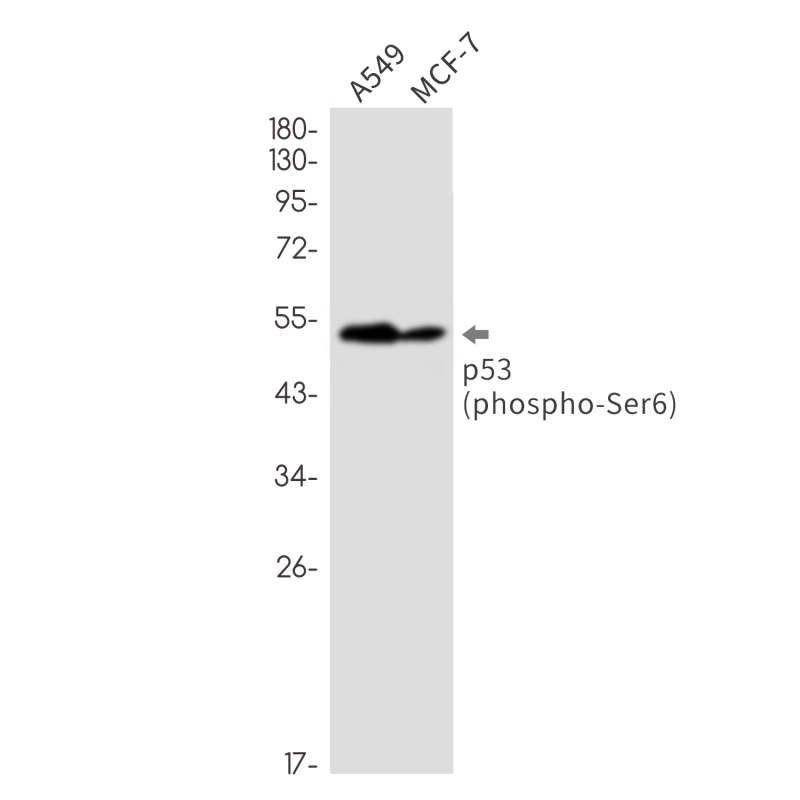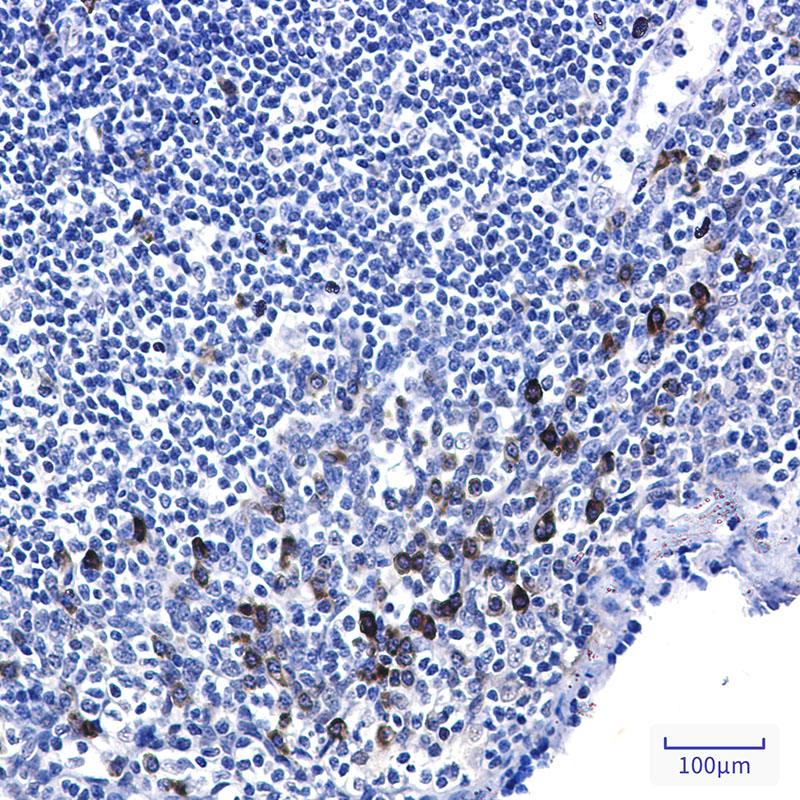

| WB | 咨询技术 | Human,Mouse,Rat |
| IF | 1/20 | Human,Mouse,Rat |
| IHC | 1/50-1/100 | Human,Mouse,Rat |
| ICC | 技术咨询 | Human,Mouse,Rat |
| FCM | 咨询技术 | Human,Mouse,Rat |
| Elisa | 咨询技术 | Human,Mouse,Rat |
| Aliases | TP53; P53; Cellular tumor antigen p53; Antigen NY-CO-13; Phosphoprotein p53; Tumor suppressor p53 |
| Entrez GeneID | 7157 |
| WB Predicted band size | Calculated MW: 44 kDa; Observed MW: 53 kDa |
| Host/Isotype | Rabbit IgG |
| Antibody Type | Primary antibody |
| Storage | Store at 4°C short term. Aliquot and store at -20°C long term. Avoid freeze/thaw cycles. |
| Species Reactivity | Human |
| Immunogen | A synthetic phosphopeptide corresponding to residues surrounding Ser6 of human p53 |
| Formulation | Purified antibody in TBS with 0.05% sodium azide,0.05%BSA and 50% glycerol. |
+ +
以下是3篇关于Phospho-p53 (Ser6)抗体的参考文献摘要:
---
1. **文献名称**:*Phosphorylation of p53 at Serine 6 by ATM is required for UV-induced apoptosis*
**作者**:Saito et al.
**摘要**:该研究报道了紫外线(UV)辐射后,ATM激酶介导p53蛋白Ser6位点的磷酸化,并通过该抗体验证了磷酸化事件。结果显示,Ser6磷酸化增强了p53的转录活性,促进细胞凋亡。
---
2. **文献名称**:*A role for p53 phosphorylation at Ser6 in modulating its subcellular localization*
**作者**:Li et al.
**摘要**:本文利用Phospho-p53 (Ser6)特异性抗体,证明电离辐射诱导的Ser6磷酸化调控p53从细胞质向细胞核的转位,进而影响其下游靶基因的激活。
---
3. **文献名称**:*Phosphorylation status of p53 at Ser6 determines oncogenic stress responses in hepatocellular carcinoma*
**作者**:Chen et al.
**摘要**:通过Western blot和免疫组化实验(使用Phospho-p53 Ser6抗体),研究发现肝癌细胞中Ser6磷酸化水平与p53介导的细胞周期阻滞相关,提示其作为肝癌治疗潜在标志物的可能性。
---
注:上述文献为示例,实际引用时建议通过PubMed或Web of Science以关键词“Phospho-p53 Ser6 antibody”或“p53 phosphorylation Ser6”检索最新研究。
The Phospho-p53 (Ser6) antibody is designed to detect p53 protein phosphorylated at serine 6. a post-translational modification critical for regulating the tumor suppressor activity of p53. The p53 protein plays a central role in maintaining genomic stability by inducing cell cycle arrest, DNA repair, or apoptosis in response to cellular stress, such as DNA damage. Phosphorylation at specific serine residues, including Ser6. modulates p53 stability, localization, and transcriptional activity.
Serine 6 phosphorylation is primarily associated with the early activation of p53 following stress signals. Studies suggest that this modification may be mediated by kinases like protein kinase C (PKC) or casein kinase 1 (CK1), though the precise regulatory mechanisms remain under investigation. Phosphorylation at Ser6 has been linked to enhanced p53 stability by potentially interfering with its ubiquitination and degradation by MDM2. a key negative regulator. Additionally, it may cooperate with other phosphorylation events (e.g., at Ser15 or Ser20) to fine-tune p53’s transcriptional activity toward target genes involved in cell fate decisions.
This antibody is widely used in cancer research to study p53 activation dynamics, DNA damage response pathways, and tumorigenesis. Its specificity enables detection of the phosphorylated form in techniques like Western blotting, immunofluorescence, or immunohistochemistry, aiding in the exploration of p53’s role in both normal physiology and disease.
×